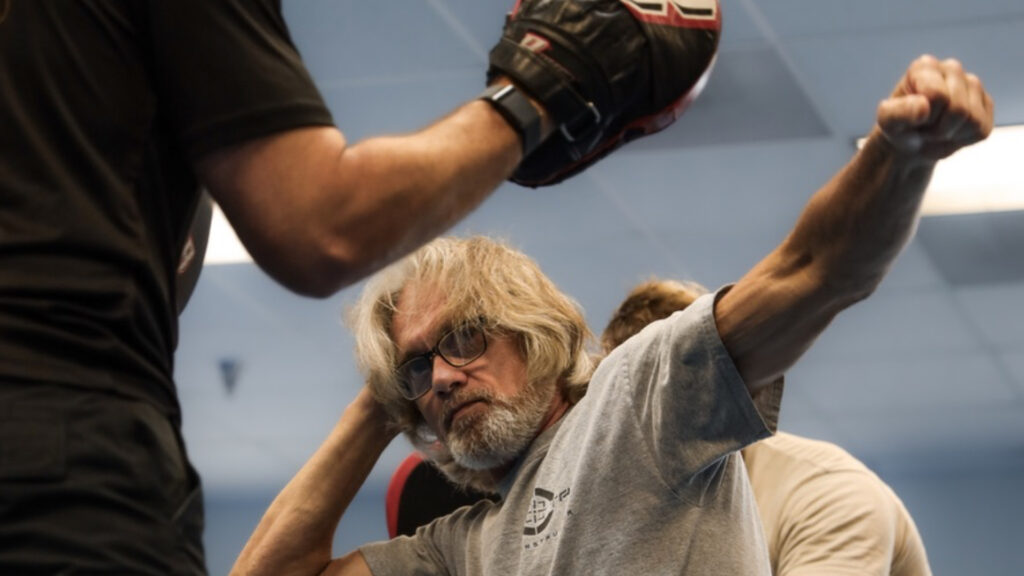
To distill the vast and complex field of martial arts into its most effective elements, I created the Combat Blueprint. Martial arts encompasses an overwhelming array of techniques and styles, making it challenging to navigate. The Combat Blueprint serves as a clear, focused guide, emphasizing the core, high-yield fundamentals that genuinely matter in combat science. It’s designed to maximize training efficiency by concentrating on elements that directly enhance skill development and combat effectiveness. Recognizing that time is one of our most valuable resources, the Blueprint ensures that every moment spent training contributes meaningfully to your progress and mastery.
For those unfamiliar with the Combat Blueprint, it is built around five core pillars of study, known as the Primal Environments. These pillars represent key aspects of combat and self-defense:
- Marksmanship – Focuses on precision and accuracy in shooting, honing the ability to effectively use firearms under pressure.
- Edged and Blunt Weaponry – Covers techniques and strategies for using knives, sticks, and improvised weapons, emphasizing adaptability in various environments.
- Striking – Concentrates on hitting techniques, including punches, elbows, knees, and kicks, while integrating body mechanics, rhythm, and range control.
- Hand Fighting/Pummeling/Giraffe Wrestling – Develops close-quarters combat skills, including grappling and clinching, with an emphasis on control and adaptability in tight spaces.
- Ground Combat – Focuses on ground-based strategies, including grappling, anti-grappling, grounded striking (Dog Boxing), and fighting with weapons on the ground.
These five pillars form the foundation of the Combat Blueprint, providing a starting point for study and application. Each pillar is essential for success in real-world violent encounters, addressing critical skills and tactics needed to prevail.
However, the Blueprint is more than just these five pillars—it is a dynamic framework for comprehensive training. It allows practitioners to craft intelligent training plans and schedules that ensure a balanced approach to skill and knowledge development. By starting with the fundamentals, you build a strong foundation that supports the progression into advanced techniques and strategies.
The Combat Blueprint is more than a training guide; it’s a tool for structuring your martial arts journey with purpose and efficiency. Whether you are refining marksmanship, exploring edged weapons, or mastering close-quarters combat, the Blueprint ensures you invest your time wisely, gaining maximum value and progression from every moment spent training. With this structured framework, you can achieve uniform growth across all aspects of combat and self-defense, becoming a well-rounded and adaptable practitioner.
The CBP Striking Section
The “Striking” section of the C-Tac Combat Blueprint is designed to equip students with the knowledge and tools to maximize the body’s striking potential. It emphasizes combining the body’s natural weapons in dynamic and fluid movements to create a robust and adaptable striking system. Just as a musician combines instruments to play a symphony, striking in combat is about harmonizing the body’s tools to deliver precise and effective force.
The Tools: Weapons of the Body
The human body is a versatile arsenal, and this section of the Combat Blueprint focuses on utilizing every available weapon:
Hand & Foot Weapons
• Explore multiple dimensions of the hand, including fists, palms, fingers, and the edge of the hand (karate chop or blade).
• Use the feet for kicks, sweeps, and stomps, adapting to various ranges and angles.
Elbow & Knee Weapons
• Generate close-range power with elbows and knees. These weapons are devastating in confined spaces and infighting scenarios.
Shoulder & Head Weapons
• Learn to incorporate the shoulder and head for unexpected strikes, especially in clinching and close-quarters combat.
Each tool is developed with a focus on precision, power, and the ability to transition seamlessly between them during combat.
The Purpose: Why Combinations Matter
Combinations are more than a series of strikes—they are the foundation for effective striking. This section focuses on the why behind combinations:
• Body Mechanics & Power:
Understand how to generate maximum force by aligning your body correctly during strikes. Combinations teach you how to chain movements for maximum impact.
• Tempo & Rhythm:
Learn how to blend strikes in fluid sequences, creating a natural rhythm that enhances speed and unpredictability.
• Range Control:
Master the different ranges between tools—whether it’s a jab at long range, a knee at mid-range, or an elbow in close quarters.
• Proper Positioning:
Develop the ability to maintain optimal body, hand, foot, and head placement while delivering strikes effectively while minimizing vulnerability.
• Protection During Attack:
Train to shield, block, and parry strikes while maintaining offensive momentum, ensuring you’re protected even as you attack.
Training Methods: Building the Skills
Striking proficiency requires consistent, focused practice with various training tools and partners. The Combat Blueprint incorporates several methods:
Bags and Mitts:
• Heavy bags for power and endurance.
• Focus mitts for precision and targeting.
Body as a Pad:
• Train with partners using controlled strikes to develop timing and real-world applications.
Weapons & Handheld Tools:
• Integrate everyday carry items like sticks or tactical pens for striking training. This is a great way to train if you do not have a partner.
Training Combo Examples: Structured Drills for Mastery
• The Dirty Dozen Drill:
A series of 12 strikes combined different tools, focusing on fluid transitions from long to close range and accuracy.
• JKD’s ABCs:
Jeet Kune Do’s Attack By Combinations sets; these drills emphasize adaptability, movement through various ranges, and efficiency in striking.
• Thai Boxing 4 Counts:
A foundational drill from Muay Thai that develops power, rhythm, and control.
• 3-for-3 Count Drills:
Both participants wear gloves, exchanging three strikes at a time to practice timing, counters, and combinations.
360 Degrees of Destructive Force: Striking in All Directions
Combat rarely happens in a straight line. The Combat Blueprint teaches students to strike effectively from all angles, ensuring adaptability in dynamic environments. Key drills include:
• 4-Man Box Drill:
Develop the ability to strike in all directions by simulating attacks from multiple opponents.
• All Striking Weapons Around the World:
Train strikes in open space, through the various positions of the around the world drill. Standing, Kneeling, Sitting, Laying.
Real-World Application: Open Space and Obstacles
Striking is often influenced by your environment. The Combat Blueprint prepares students to adapt their striking in various settings:
Open Space:
• Practice movement and range control in open space. this is the most common practice you see in most martial arts.
Walls & Corners:
• Learn how to use vertical surfaces and confined spaces to your advantage, leveraging walls and other everyday environments.
Tables & Chairs:
• Train to strike and maneuver effectively in cluttered environments, such as restaurants or offices.
Conclusion: The Symphony of Striking
The “Striking” section of the C-Tac Combat Blueprint emphasizes that striking is not just about power—it’s aboutprecision, adaptability, and fluidity. By learning to combine the body’s natural weapons, understanding the why behind combinations, and training in varied environments, students can master the art of striking. Whether you’re a seasoned practitioner or a beginner, the principles and drills in this section will help you build a well-rounded striking game that’s effective in any situation.
Are you ready to play the music of combat and master your striking arsenal? Let’s get to work!
Shift Your Perspective, Take Action, & Lead Yourself To Greatness
~ Sifu Alan

Alan Baker is renowned for his dual expertise in crafting tailored Defensive Tactics Programs and high-performance coaching. Catering specifically to law enforcement agencies, military organizations, and security firms, Alan designs training regimens that emphasize practical techniques, real-world adaptability, and scenario-based training. His approach enhances the capabilities and readiness of personnel in intense situations. His clients include the Executive Protection Institute, Vehicle Dynamics Institute, The Warrior Poet Society, ALIVE Active Shooter Training, Retired Navy SEAL Jason Redman, Tactical 21, and many others. Sifu Alan is the creator of the C-Tac® (Civilian Tactical Training Association) System and
Protection Response Tactics (PRT), two highly regarded training systems that emphasize realistic, adaptive techniques for both civilians and professionals in high-risk fields. Explore Alan’s tailored programs here. Sifu Alan travels across the U.S., teaching camps and seminars on the programs he’s developed and the multiple martial arts he has studied for nearly five decades.
Beyond mere tactics, Alan stands out as the paramount “Self Leadership” coach, adept at unlocking the vast potential within individuals. With a deep passion for mentoring professionals, entrepreneurs, and those on personal growth odysseys, he focuses on nurturing a mindset of excellence. Alan’s coaching hinges on practical strategies that bolster mental resilience, focus, and drive. Teaming up with Alan means embarking on a transformative path where mental barriers are dismantled, inherent strengths come to the fore, and your goals become within clear sight. His profound insights enhance performance and sculpt a mindset tailored for triumphant success.
To delve deeper into Alan’s mindset philosophy, peruse his enlightening collection of books. If you’re ready to amplify your journey under Alan’s tutelage, connect through his official website.
